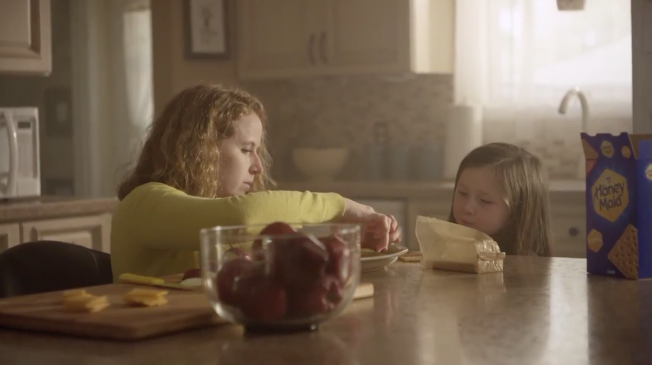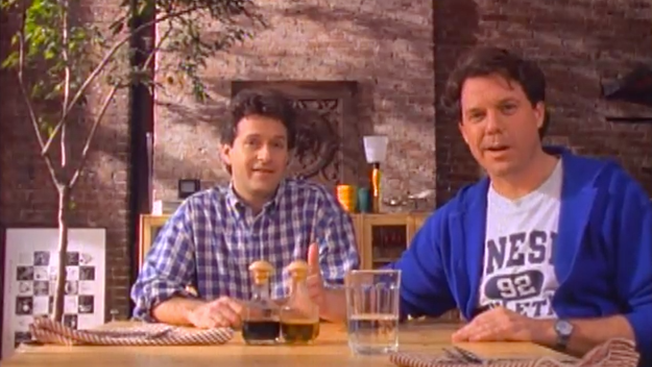Honey Maid's Latest Wholesome Family Features a Disabled Aunt and Her Niece
Posted in: Uncategorized
Honey Maid’s campaign featuring inclusive depictions of American families takes another step forward today with a spot showing a disabled aunt and her niece making apple and cheddar melts together on their graham crackers.
It’s a simple, quiet 30-second spot, Cheerios-like both in its simplicity and its unspoken embrace of all types of families. Honey Maid has become one of the most famous brands embracing such diversity in its ads with same-sex couples, mixed-race, blended and immigrant families, and more.
The aunt in the ad is Stephanie Woodward, a disability rights lawyer and activist who is currently director of advocacy at The Center for Disability Rights. She signed on for the project, Honey Maid says, because she—and many in the disabled community—want real disabled people featured on TV and in the media, not actors playing disabled people.
Here is the 30-second online version of the spot:
Woodward was also drawn to the simple realism of the ad in a media landscape where disabled people are often portrayed “in either a pity or a superhero light.” (By the way, while there is much debate around the language of disability, Woodward prefers the term disabled person to person with a disability. “I am a proud disabled woman and prefer not to identify with ‘people first’ language as it separates me from my disability identity,” she says.)
The latest spot coincides with this weekend’s 25th anniversary of the signing into law of 1990’s Americans with Disabilities Act. Honey Maid says the ad is also one of the first to include audio descriptions on the 15-second TV version—describing what’s happening on screen for blind and low-vision audiences—along with standard closed captioning. The audio description will run on Bravo, E!, Nick @ Nite, Lifetime, LMN, CBS and ABC.
“The ‘This Is Wholesome’ campaign launched in March of 2014 and has been committed to featuring a cross-section of the American family,” says Gary Osifchin, portfolio lead for biscuits at Mondel?z International. “From a same-sex couple and single dad, to a mixed-race military family, a blended and an immigrant family, the sweet moments between a disabled aunt and her niece are just another example of Honey Maid’s commitment to feature real American families and the wholesome connections they share.”
Here is the 15-second TV version:
CREDITS
Client: Honey Maid / Mond?lez International
Senior Director, Biscuits North America: Gary Osifchin
Senior Brand Manager: Mikhail Chapnik
Senior Associate Brand Manager: Jared Moran
Campaign: “This is Wholesome”
Title: Honey Maid: How to Make Apple & Cheddar Melts
Agency: Droga5 NY
Creative Chairman: David Droga
Chief Creative Officer: Ted Royer
Executive Creative Director: Kevin Brady
Associate Creative Director: Tara Lawall
Associate Creative Director: Devon Hong
Copywriter: German Rivera Hudders
Art Director: J.J. Kraft
Chief Creation Officer: Sally-Ann Dale
Associate Broadcast Producer: Goldie Robbens
Global Chief Strategy Officer: Jonny Bauer
Group Strategy Director: Matt Springate
Senior Communications Strategist: Taylor Hines
Senior Social Strategist: Kat Popiel
Social Media Manager: Rob Engelsman
Data Strategy Director: Katty Lein
Data Strategist: Annie Corbett
Group Account Director: Brett Edgar
Account Director: Amanda Chandler
Account Manager: Jasmine McDavid
Associate Account Manager: Amy Rosenberg
Project Manager: Andra Johnson
Production Company: Variable
Director: Jonathan Bregel
DOP: Stuart Winecoff
Executive Producer: Tyler Ginter
Producer: Alex Friedman
Production Supervisor: Paige DeMarco
Editorial & Post Production & Audio: D5 Studios
Music: de Wolfe Music
Droga5 Celebrates ‘4 de Julio’ for Honey Maid
Posted in: UncategorizedDroga5 launched a new Independence Day iteration of its “This Is Wholesome” campaign for Mondelez brand Honey Maid, entitled “4 de Julio,” which follows the agency’s September effort celebrating blended families.
The new spot celebrates the Domincan Gomez family, and explores how father Arisandy, an environmental engineer, and mother, Cindy, a realtor, teach their children, and Cindy’s mother, Alesandrina about American pride and celebrate the Fourth of July. “4 de Julio” begins with Arisandy describing some of the difficulties he faced when he first immigrated to America and became a citizen, simultaneously feeling invisible and discriminated against. He and his wife go on to describe the values they pass on to their children, coupled with footage of the family’s celebration of the holiday, complete with s’mores. The spot’s message, as delivered by Cindy is that the family is made up of “normal human beings, going through struggles just like everyone else,” every bit as American as any other family. It’s a message that should almost go without saying, but in a nation where certain conservative politicians still trade in racism and xenophobia, a very necessary one.
“Honey Maid has a history of celebrating all families and the wholesome moments that make them who they are,” said Gary Osifchin, portfolio lead, biscuits, Mondel?z International. “The Gomezes embody the resonant strength behind America’s blended and diverse culture. It is an honor to highlight their family’s experiences and traditions this Fourth of July.”
20 Years Before It Was Cool to Cast Gay Couples, Ikea Made This Pioneering Ad
Posted in: Uncategorized
The mini-wave of brands casting gay couples in TV ads this year continues to rise, with the likes of Honey Maid, Cheerios, and DirecTV all diving in. More power to them. But Ikea was the first marketer to feature a gay couple in a mainstream commercial. Twenty years ago.
The 1994 spot below, from Deutsch, ran after 10 p.m. in three markets where Ikea then had a significant presence: New York, Philadelphia and Washington, D.C. The late-night airing ensured that the ad wouldn’t be seen during “family hour” programming. That concession, however, did little to quell the objections of the American Family Association and its leader, the Rev. Donald Wildmon.
Wildmon called for boycotts of Ikea stores, one of which, on Long Island, was the target of a bomb threat, which turned out to be unfounded. The retailer, however, continued to air the ad, which was part of a lifestyle campaign featuring different types of consumers (a divorced mom, adopting parents, empty nesters, etc.) that began in 1993.
The creative team behind “Dining Room,” including creative director Greg DiNoto, associate cd Kathy Delaney, copywriter Dallas Itzen and art director Patrick O’Neill, are no longer at Deutsch. But O’Neill, who later worked at TBWAChiatDay and now is chief creative officer at blood testing company Theranos, shared his memories of helping to create something that didn’t win awards but was truly groundbreaking.
brightcove.createExperiences();
AdFreak: Where did the idea for “Dining Room” come from?
Patrick O’Neill: We would base a lot of our stories on the real people we would see. We’d go to the New Jersey store—in Elizabeth—and because [the ads] were based on real people, we would watch, observe and see how people use the product, who they were, what kinds of things they were buying. And we’d figure which stores were the best ones. And there were a lot of gay couples there. We thought, Why don’t we do one? Donny [Deutsch] thought it was a great idea and felt like it was a true representation of Ikea’s values, which is they’re always accepting of everyone.
So, that store was like your focus group or idea center?
It was. And we figured out where life intersected with furniture. … You had to understand what was going on in the culture at that time, I thought, versus just doing [ads] in a sort of timeless manner. Divorcees still go there, that kid still gets adopted, and gay couples still go there, you know [laughs]. It just wasn’t a typical depiction in media.
What was the shoot like?
A lot of the grips and all the people that were working on the set—you could feel that there was a lot of tension in the air because it was so unusual to see.
Did you shoot it at the store?
Yes.
Who was the director?
Paul Goldman. He had just started directing. [At Deutsch] he worked on the original “It’s a big country. Someone’s got to furnish it” campaign that was the year before.
How nervous was Ikea going into this?
They believed in it from the beginning. They were never nervous about it.
Did you have to test it?
No.
Did you think at the time that more people would follow in the footsteps of that ad?
I did.
Why didn’t that happen?
It’s interesting. I think the reason why people remember the ad was because it was done in a way where it was, “Wow, they really did it.” We weren’t mucking around. It was clear what was going on. And there were bomb threats. There was backlash. There were New York op-eds written about it. I mean, there were all kinds of things happening. In the years that followed—not too long after—Ellen [DeGeneres], she came out. Melissa Etheridge came out. A lot of women came out at the time. So, I think the culture started doing it without it being commercials. But as far as brands, I think they were nervous about it.
Does the groundswell we’re seeing now reflect what’s going on with state marriage laws?
Yeah. I think it’s also that the millennials and younger are very accepting of [gay] marriage. When that is legitimized by a large core of consumers, you can have that in communications because the approval rating for that is much, much higher once you get to a certain age group.
Would a different creative team have done the same thing?
No. … Look, the way we cast, and had them speak about their relationship, and the premise—it was all based on real stuff. I think the reason it turned out the way it did was all those people working together on it. We knew gay people, and I felt like the lone representative [laughs]. I felt a lot of responsibility making sure I didn’t let my people down.
How proud are you of this, ultimately, and is it still up there in your top three ads?
Well, I’m proud of it because it was the first one. It was scary in some ways. Everyone was true to the period, but there was no precedent. And it wasn’t a welcoming environment. So, that part of it makes me proud and happy to be part of.
![]()
Honey Maid Has a Pretty Cool Reply to All the Haters of Its Ultra-Inclusive Ad
Posted in: Uncategorized
Marketers who make ads about inclusive families these days need a battle plan for how to deal with the haters. And it's as much an opportunity as a crisis.
It began, of course, with Cheerios, which was surely legitimately surprised last year when its ad with the interracial family was flooded with racist comments on YouTube. General Mills' reaction was complicated. First it shut down the YouTube comments, then it slowly embraced what quickly became an outpouring of support—and finally it aired a brilliantly subtle sequel on this year's Super Bowl.
Advertisers who do this kind of progressive marketing are surprised by the haters no longer. In fact, I'd be willing to bet Honey Maid and Droga5 already had a plan in place for the video below—a response to the haters (and supporters) of its ultra-inclusive "This Is Wholesome" ad—before the first spot (which now has more than 4 million views) even aired.
Is that a cynical way to approach inclusive messaging—to calculatingly harness the hatred against it to sell more stuff? Perhaps. Still, it's quite amusing to see the haters turned into pawns who can be played for extra exposure.
Here's the original ad:
![]()
